高中英语必修三Reading(公开课)
- 格式:ppt
- 大小:3.47 MB
- 文档页数:23

2019新人教高中英语必修三Unit3 Diverse CulturesReading for writing 公开课教案Teaching aims:1.Enable students to acquire some basic information about San Francisco’s Chinatown.2.Enable students to figure out the organisation and language feature of the text.3.Help students to identify the cultural characteristics of Chinatown and the relationship between Chinese culture and American multiculturalism.4.Guide students to write an introduction to your city/town and write an outline of your introduction.Teaching key points:1.Analyse the organisation and language feature of the text.2.Cultivate students to write an introduction to your city/ town properly and concisely according to an actual situation.Teaching difficult points:1.Enable students to figure out the organisation and language feature of the text.2.Guide students to introduce their city or town in a comprehensive,accurate and organised way.Teaching procedures:StepⅠBefore readingTalk about your travel experience and ask students to give you some advice and information as you plan to travel to San Francisco’s Chinatown.T:Class, I plan to travel to America and my destination will be Chinatown in San Francisco. How do you know about Chinatown? Can you give me some advice and information to help me know more about Chinatown?Ss: Firstly, it is the place where the Chinese immigrants live. Secondly, you canexplore the interesting sights,experience traditional Chinese culture, go shopping, eat Chinese food, and so on.Step ⅠWhile readingCultural NoteThe Dragon Gate is the most photographed site in San Francisco’s Chinatown.The gate was designed by three Chinese-American architects in 1967 using traditional Chinese village gates for inspiration.The Tin How Temple is the oldest Taoist temple in Chinatown,and one of the oldest Chinese temples in the United States.The temple was built in 1852,but then destroyed by the 1906 earthquake.The image of the goddess Mazu was preserved,as well as part of the altar and the bell.These were relocated to the top floor of a building constructed on the site of the old temple.The Bank of Canton is actually the old Chinese Telephone Exchange,a traditional Chinese-style building constructed in 1894.When the telephone was first introduced,there was no way to dial a number.Instead,you would have to talk to a switchboard operator (nearly always a woman),tell her the telephone number of the person you wanted to talk to,and she would manually connect you to the person you wanted to call using an electric plug.However,Chinese residents thought it was impolite to use a number to refer to a person,so the switchboard operators in Chinatown had to know all the names and addresses of everyone in Chinatown so they would know who to connect people to.They also had to know five dialects of Chinese and speak English.Like many buildings in Chinatown,the Chinese Telephone Exchange was destroyed by the 1906 earthquake,but it was quickly rebuilt.However,in 1949 it was closed when dial telephones made switchboards unnecessary.Portsmouth Square,now a public park,is the site of San Francisco’s first public square,built in the early 19th century.While many important historical events related to California and San Francisco occurred in the square before Chinatown was established or grew in size,the site is now very much considered an integral part of Chinatown.The Scottish novelist Robert Louis Stevenson (1850—1894) lived in San Francisco briefly between 1879—1880,and spent much time in Portsmouth Square during his stay there.There is a monument in his honour in the park.Activity 1Prediction1.Look at the title and picture and predict what kind of article is this?2.Who are the target readers?3.What is the writer’s purpose of writing this text?Suggested answers:1.This is an introduction to Chinatown in San Francisco.2.Visitors.3.To introduce a diverse cultural Chinatown in San Francisco to visitors.Activity 2 Reading for main ideaRead the text quickly and match the main idea of the passage.Para.1 A.The characteristic of Chinatown.Para.2 B.The history of Chinatown.Para.3 C.The introduction of Chinatown’s shops and products.Para.4 D.The origin of Chinatown.Para.5 E.The existence value of Chinatown.Para.6 F.The famous food and drinks of Chinatown.Suggested answers:Para.1:A Para.2:D Para.3:B Para.4:C Para.5:F Para.6:EActivity 3 Reading for detailsRead the passage again and answer the questions.1.What are the famous tourist sites in the Chinatown of San Francisco?2.Which is the best season to visit the Chinatown in San Francisco?3.What else can you do there?Suggested answers:1.Dragon Gate,Tin How Temple,Bank of Canton,and Portsmouth Square.2.All year round.3.We can explore the interesting sights,experience traditional Chinese culture,goshopping,eat Chinese food,and so on.Activity 4Reading for organisation and language featuresRead the text again and study the organisation and language feature.1.What information is included in the introduction? Tick the items that are mentioned.2.Underline the sentences that are used to describe the items above.Location:______________________Climate:________________________________History:_____________________________________Ethnic groups:____________________________________Languages:_____________________________________________Famous figures:_____________________________________________Famous food/drink:_______________________________________________ Tourist attractions:_________________________________________________ Businesses and industries:_____________________________________________3.Fill in the blanks to show the structure of the text.Paragraph(s)Main ideaDetails Expressions1 Introductionsh ortintrodu ction to San Francisc o’s Chinato wn2—5 Bodywhat youcan findand doin San Francisco’sChina-town23456 Summaryim portanc e of Chinato wnSuggested answers: 1.2.Location:in San FranciscoClimate:mild all year roundHistory:Chinese immigrants settled in the area during the railroad construction and gold rush periodEthnic groups:the majority of residents in Chinatown are still ethnic ChineseLanguages:many of whom do not speak English fluentlyFamous figures:Robert LouisFamous food/drink:traditional dishes from all over ChinaTourist attractions:Dragon Gate,Tin How Temple,Bank of Canton,Portsmouth SquareBusinesses and industries:souvenirs,goods,and clothing;all kinds of traditional Chinese herbal medicine;Chinese tea stores3.Pa ragraph (s)MainideaDetails Expressions1Int roducti onshortintroduction toSanFrancisco’sChinatownlocation,features,climatebiggest,oldest,very popular tourist draw,mild allyear round2—5what you2history,ethnichistorically...what started as...then turnedinto...the majority of residents...a real taste of ChinaBo dy canfindand doin SanFrancisco’sChinatowngroups,language3attractions,famous figuresfamous sites include....to name but a few,spendhours just exploring the interesting sights,smells,andsounds of China,a key site.a great place to...4storesand goodsoffer a unique range of...all kinds of...can befound,varieties of5foodtreasure,suit everyone’s taste,traditional dishesfrom all over China6 Summa ryimportance ofChinatownuniquecultureallow...to...experience...first handStepⅠ Describing a place with distinctive cultural identity1.In groups,brainstorm as much information as possible about your city/town and its culture.Then write an outline of your introduction.①What is unique about your city/town?②Is it a city/town with diverse cultures?③What examples can you give to illustrate its feature?2.Write an introduction to your city/town.The following phrases and expressions may help you.·is located in/on·has a history of...years·is divided up into·has a population of·is...in size·is home to...ethnic groups·the most popular/greatest/largest·popular festivals/foods/tourist sights include...Suggested answers:1.①My city is distinctive cultural identity.②Yes,it is a city/town with diverse cultures.③I will give examples such as history,population...to illustrate its features.2.Lijiang is an ancient city high up in the mountains of Yunnan,near the borders of Sichuan and Tibet.It was an important stop on the Ancient Tea and Horse Road,which connected central China with Myanmar and India,transporting not just tea but also silk and other goods.Lijiang’s Old Town,with a history of over 800 years,is a UNESCO World Heritage Site.Today,Lijiang is mostly known for its ethnic minority culture,especially the culture of the Naxi ethnic group.The Naxi are famous for their Dongba culture.They have their own unique written language that uses pictures and symbols.They also create beautiful arts and crafts,and are well known for their singing and dancing.Strolling around the Old Town,one can witness Naxi life much as it was hundreds of years ago.One can also try traditional Naxi food,including the air-dried pork liver,Naxi baba (a kind of flat bread),and Naxi hot pot.But if you really want to see Naxi traditional culture,it is best to visit during the Torch Festival,which usually occurs in the summer.During the festival,the streets are full of torches,bonfires,and lots of people singing and dancing.While the main ethnic group living in the area is the Naxi,there are also at least 19 other ethnic groups,including Yi,Lisu,Bai,Tibetan,and Pumi.It is easy to arrange a short homestay with an ethnic minority family to learn more about their way of life.Just outside the city,there are beautiful mountains,meadows,lakes,rivers,and gorges,offering plenty of opportunities to go hiking,kayaking,or rafting.Like much of Yunnan,the weather is always fairly mild in Lijiang,so it is fine to visit throughout the year.Lijiang can be easily reached by airplane or train,and visitors can hire bikes or cars to explore the area.It is the perfect place for tourists to experience the colourful culture of China’s ethnic minorities.StepⅠEvaluating and polishing the draft1.Exchange drafts with a e the checklist to give feedback on your partner’s draft.2.Get your draft back and revise it.3.Put up your introduction in your classroom or share it with the class.StepⅠHomework书面表达:请阅读下面有关中国题材纪录片(documentary)的对话,并按照要求用英语写一篇150个词左右的文章。
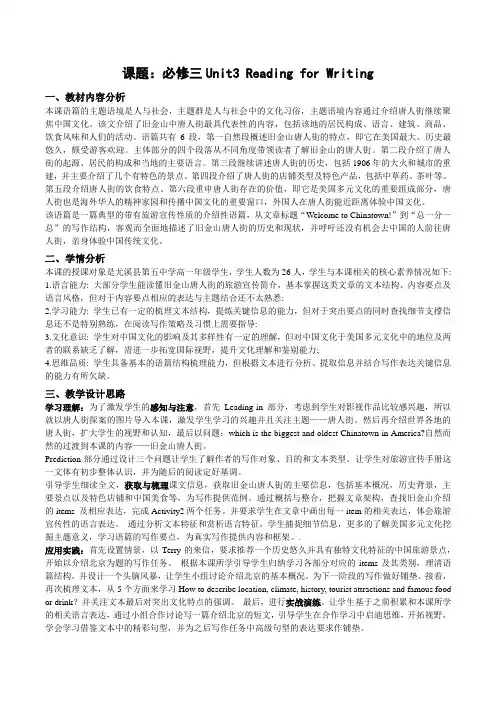
课题:必修三Unit3 Reading for Writing一、教材内容分析本课语篇的主题语境是人与社会,主题群是人与社会中的文化习俗,主题语境内容通过介绍唐人街继续聚焦中国文化。
该文介绍了旧金山中唐人街最具代表性的内容,包括该地的居民构成、语言、建筑、商品、饮食风味和人们的活动。
语篇共有6段,第一自然段概述旧金山唐人街的特点,即它在美国最大、历史最悠久,颇受游客欢迎。
主体部分的四个段落从不同角度带领读者了解旧金山的唐人街。
第二段介绍了唐人街的起源、居民的构成和当地的主要语言。
第三段继续讲述唐人街的历史,包括1906年的大火和城市的重建,并主要介绍了几个有特色的景点。
第四段介绍了唐人街的店铺类型及特色产品,包括中草药、茶叶等。
第五段介绍唐人街的饮食特点。
第六段重申唐人街存在的价值,即它是美国多元文化的重要组成部分,唐人街也是海外华人的精神家园和传播中国文化的重要窗口,外国人在唐人街能近距离体验中国文化。
该语篇是一篇典型的带有旅游宣传性质的介绍性语篇,从文章标题“Welcome to Chinatown!”到“总一分一总”的写作结构,客观而全面地描述了旧金山唐人街的历史和现状,并呼吁还没有机会去中国的人前往唐人街,亲身体验中国传统文化。
二、学情分析本课的授课对象是尤溪县第五中学高一年级学生,学生人数为26人,学生与本课相关的核心素养情况如下: 1.语言能力: 大部分学生能读懂旧金山唐人街的旅游宣传简介,基本掌握这类文章的文本结构、内容要点及语言风格,但对于内容要点相应的表达与主题结合还不太熟悉:2.学习能力: 学生已有一定的梳理文本结构,提炼关键信息的能力,但对于突出要点的同时查找细节支撑信息还不是特别熟练,在阅读写作策略及习惯上需要指导:3.文化意识: 学生对中国文化的影响及其多样性有一定的理解,但对中国文化于美国多元文化中的地位及两者的联系缺乏了解,需进一步拓宽国际视野,提升文化理解和鉴别能力;4.思维品质: 学生具备基本的语篇结构梳理能力,但根据文本进行分析、提取信息并结合写作表达关键信息的能力有所欠缺。
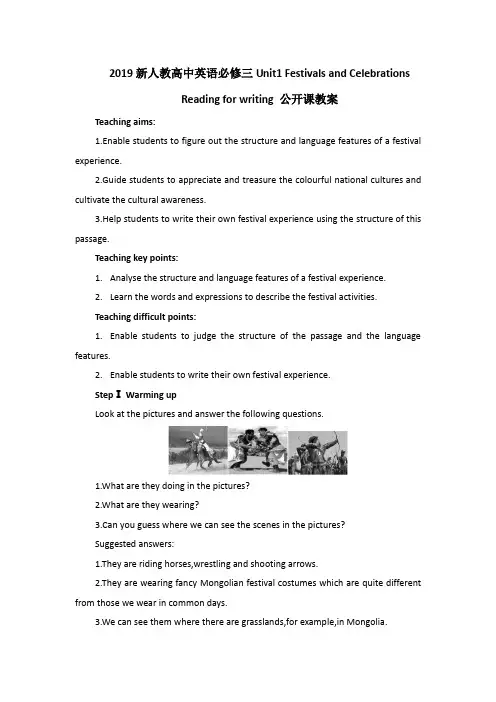
2019新人教高中英语必修三Unit1 Festivals and CelebrationsReading for writing 公开课教案Teaching aims:1.Enable students to figure out the structure and language features of a festival experience.2.Guide students to appreciate and treasure the colourful national cultures and cultivate the cultural awareness.3.Help students to write their own festival experience using the structure of this passage.Teaching key points:1.Analyse the structure and language features of a festival experience.2.Learn the words and expressions to describe the festival activities.Teaching difficult points:1.Enable students to judge the structure of the passage and the language features.2.Enable students to write their own festival experience.StepⅠ Warming upLook at the pictures and answer the following questions.1.What are they doing in the pictures?2.What are they wearing?3.Can you guess where we can see the scenes in the pictures?Suggested answers:1.They are riding horses,wrestling and shooting arrows.2.They are wearing fancy Mongolian festival costumes which are quite different from those we wear in common days.3.We can see them where there are grasslands,for example,in Mongolia.StepⅡReading the diaryActivity 1 Make a predictionFrom the title,we can find that the text is mainly about and the writer feels at it.Activity 2 Reading for main ideasRead the diary and try to find out the topic sentences of each paragraph.Para.1:______________________________________________Para.2:______________________________________________Para.3:______________________________________________Para.4:______________________________________________Para.5:______________________________________________Suggested answersActivity 1the writer’s experience of taking part in Naadam;amazedActivity 2Para. 1:I experienced the Naadam Festival in China’s Inner Mongolia Autonomous Region for the first time this year.Para. 2:On the first day,I set off to the games early with my friend Burin.Para. 3:After the opening ceremony and some amazing performances, the wrestling competition began.Para. 4:I absolutely enjoyed the archery,too,but the horse races were my favourite part.Para. 5:I’m finally back home now,feeling really tired,but celebrating Naadam with my friend was totally worth it.Activity 3 Reading for details1.Read paragraph 1,and try to find out the answers to the following questions.(1)How does the writer express the date of the festival?(2)What would be included in the following paragraphs?(3)What did the writer think of the things?Suggested answers:(1)The festival falls on the fourth day of the sixth month of the lunar calendar,usually lasting for three days.(2)Horse racing,wrestling and archery may be included in the following passage.(3)Amazing.2.Read paragraph 2,and try to find out the answers to the following questions.(1)What were people doing when I arrived at the games?(2)Was the writer describing a person,a place or a scene to us in this paragraph?Suggested answers:(1)People were preparing for the games.(2)Yes. By using“some were feeding...some were practising...and others were chatting...”,the writer described a scene where there were so many people.3.Read paragraph 3,and try to find out the answers to the following questions.(1)How did the competitors appear onto the green field?(2)How did I feel?Suggested answers:(1)The competitors danced onto the green field,waving their arms in the air as if they were eagles.(2)I was moved by their show of strength and grace.4.Read paragraph 4,and try to find out the answer to the following question.What did the writer think of the horse races?Suggested answers:The writer thought they were surprising,worrying and important,and he enjoyed them absolutely.5.Read paragraph 5,and try to fill in the blank.In this paragraph,the writer makes a brief of his experience,which works as a closing paragraph.Suggested answer:SummaryActivity 4 Reading for language features1.Rewrite the opening paragraph of the article using the following patterns.·This was my first time spending... and it was an enjoyable and exciting experience for me.·I’ll never forget...because...·I’ll always...because...2.The passage is a diary,and it is written mainly in person and tense.3.Please find out the sentences in the present tense and think them over to find out why.Suggested answers:1.This was my first time spending three days in China’s Inner Mongolia Autonomous Region experiencing the Naadam Festival represented by three events:horse racing,wrestling,and archery and it was an enjoyable and exciting experience for me.·I’ll never forget my experience at the Naadam Festival because it was my first time to watch the exciting Mongolian games of horse racing,wrestling,and archery so closely.·I’ll always remember my first experience at the Naadam Festival in China’s Inner Mongolia Autonomous Region because it was so amazing to spend three days witnessing a grand Mongolian ceremony.2.the first;simple past3.(1)The festival falls on the fourth day of the sixth month of the lunar calendar,usually lasting for three days.Naadam means “games” in Mongolian,and it is represented by three events:horse racing,wrestling,and archery,which are all so exciting to watch!(2)Mongolian wrestling is different from the wrestling in the Olympic Games.There are no rounds,and wrestlers are not separated by weight.The wrestler loses if any part of his body above his knee touches the ground.(3)Don’t worry.They’ve been riding horses all their lives.They’ll be just fine.(4)I’m finally back home now,feeling....I can’t wait!Activity 5 Reading for the structureSuggested answers:StepⅢWritingUse what you have learnt to write about a festival or a celebration you have experienced recently.Activity 1 Writing your draftMake notes of your ideas in the table and then write your draft.OutlineThe name of the festival/celebration:Main idea of each paragraphTopic sentenceof each paragraphDetails Feelings1The topic and my feeling2How I prepared for the festival/cel ebration3 Thefestival/cel ebration activities4A summary of my festival/cel ebration experienceSuggested answers:OutlineThe name of the festival/celebration:The Lantern FestivalMain idea of each paragraphTopicsentence ofeachparagraphDetails Feelings1 Thetopicand myfeelingThis wasmy first timespending theLanternFestival withmyclassmate,which was anunforgettableexperience forme.TheLanternFestival fallson...joyfully;has a great infl-uenceon Chinese people today2 How IpreparDuringtheLanternshows;guessiextremely exciteded for the festival /celebr ation festival,therewere lanternsof variousshapes andsizes hanging throughout thestreets,attracting countlessvisitors.ngriddles;received a littlegift3 Thefestival/celebrationactivitiesWe alsoatetangyuan,which tasted sweetand delicious.has asimilarpronunciation with;theround shaperepresents;set offfire-worksand watchedthe dragondancehappy and joyful4Asummary ofmyfestival/celebrationexperienceWith myclassmate, Ispent anexciting andmeaningfulLanternFestival.exciting andmeaningful;looking forward toActivity 2 Evaluating and polishing the draft1.Exchange drafts with your e the checklists to give feedback on each other’s draft.ing form correctly in the writing?2.Get your draft back and revise it.3.Polish your draft and share it with your partner.Suggested answers:The Lantern FestivalThis was my first time spending the Lantern Festival with my classmate,which was an unforgettable experience for me.The Lantern Festival falls on the fifteenth day of the first month of the lunar year.The custom of joyfully celebrating the Lantern Festival began as early as the Western Han Dynasty,and still has a great influence on Chinese people today.During the festival,there were lanterns of various shapes and sizes hanging throughout the streets,attracting countless ntern shows were also organised,which created a festive atmosphere.What impressed me most was guessing riddles,as riddle guessing was interesting and full of wisdom.Many of the lanterns had riddles written on them and we couldn’t wait to go to the owners to check our answers.At last we received a little gift,extremely excited.We also ate tangyuan,which tasted sweet and delicious.Tangyuan in Chinese has a similar pronunciation with tuanyuan and the round shape represents reunion,harmony,and happiness.Besides,we set off fireworks and watched the dragon dance.With my classmate,I spent an exciting and meaningful Lantern Festival.Looking forward to the next festival.Part ⅣHomework书面表达(一)假如你是来自美国的留学生Mike,去年你和寄宿家庭一起过了春节,请你根据以下内容,描述一下你的过节经历和感受。

新人教版(2019)英语必修三Unit 3Period 4 Reading for Writing教学设计Invite us to a cultural diversity fest.Through background reading, students should learn how to find out the key information in a passage and lead students tounderstand the definition of China town, Chinese immigrant and archway.✧ Chinatown ✧ Chineseimmigrant ✧ ArchwayStep 3Background readingTeacher guides students to read a Travel Page to Chinatown, San Francisco and complete the trivia quizzes to get the task card.- Guide students to get the key information quickly and correctly.Step 4Let’s answerTeacher chooses students to answer the questions.1. How many Chinatowns are there in the world?A. 35 Chinatowns in 19 countriesB. 16 Chinatowns in 15 countriesC. 12 Chinatowns in 8 countriesD. 7 Chinatowns in 5 countries2. The first Chinese immigrants arrived in San Francisco in ______. A. 1402 B. 1882 C. 1848 D. 19063. Which picture does NOT include an archway ?keys:1. A 2. C 3. FGet the Task Card Task 1: PredictionTask 2: Global Reading- Provide some backgroundinformation for students.Expressions in Paragraph 1location, features, climateExpressions in Paragraph 2history, ethnic group, languageExpressions in Paragraph 3tourist attractions, famous figuresExpressions in Paragraph 4storesExpressions in Paragraph 4foodExpressions in Paragraph 4unique cultureTask 4: Critical thinkingDo you think your hometown is a city withcultural diversity? Why?While-writingStep 6Write an introduction to a place with distinctive cultural identity.1.I n groups. brainstorm as much information aspossible about your city/town and its culture.Then write an outline of your introduction.2.T hink about the following questions:Is it a city/town/district with diverse cultures?What is unique about this place?What examples can you give to illustrate itsfeature?Students learn howto introduce a place.-Get the tips ofwriting.-Improve theirfast-writingskill.Take Wuhan as an example. Watch an introduction video to Wuhan and ask students to take notes about the facts of Wuhan to prepare for their own writing.W-Water (tourist attractions)U-University(education)H-High technology(business)A-Automobile(industries)N-Noodles(Food)3.W rite an introduction to your city/town. Thefollowing phrases and expressions may you.•is located in/on•is divided up into•is … in size•the most popular/greatest/largest•has a history of … years•has a population of•is home to…ethnic groups•popular festivals/foods/tourist sites include ... Tips for Writing an Introduction to a City1.Discuss one aspect of the city in each paragraph. For example, one paragraph about general facts and population, one paragraph about industries, one paragraph about culture, etc.e search engines such as Baidu to help you find facts about the city.e 'its' as a possessive when writing about a city (not her, or his). For example, Its main exports are ...4.When using numbers, write out the numbers up to twenty. For larger numbers, use numerals. For example: There are two professional sports organizations ... BUT There are over 130,000。
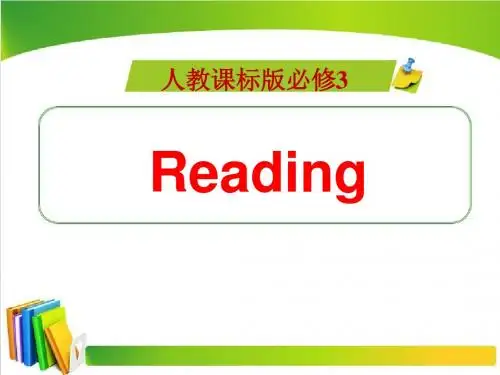
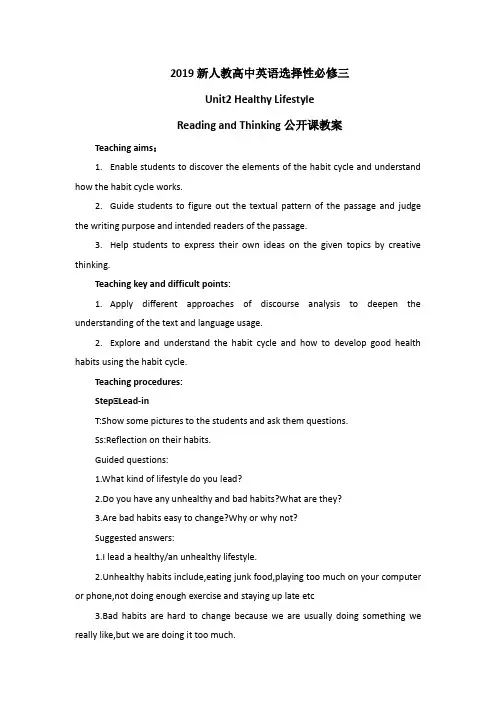
2019新人教高中英语选择性必修三Unit2 Healthy LifestyleReading and Thinking公开课教案Teaching aims:1.Enable students to discover the elements of the habit cycle and understand how the habit cycle works.2.Guide students to figure out the textual pattern of the passage and judge the writing purpose and intended readers of the passage.3.Help students to express their own ideas on the given topics by creative thinking.Teaching key and difficult points:1.Apply different approaches of discourse analysis to deepen the understanding of the text and language usage.2.Explore and understand the habit cycle and how to develop good health habits using the habit cycle.Teaching procedures:StepⅠLead-inT:Show some pictures to the students and ask them questions.Ss:Reflection on their habits.Guided questions:1.What kind of lifestyle do you lead?2.Do you have any unhealthy and bad habits?What are they?3.Are bad habits easy to change?Why or why not?Suggested answers:1.I lead a healthy/an unhealthy lifestyle.2.Unhealthy habits include,eating junk food,playing too much on your computer or phone,not doing enough exercise and staying up late etc3.Bad habits are hard to change because we are usually doing something we really like,but we are doing it too much.StepⅠTextual Pattern AnalysisT:Get everyone to figure out the discourse pattern of the whole passage and paragraphs as well.Ss;Dig into the whole passage and find out the elements of the habit cycle and how the habit cycle works.Guided questions:1.What can we guess from the title?2.What’s the main idea of each paragraph?3.How many parts are there in the text?What’s the relationship between them?4.How is the text developed?5.What is the conclusion of this part?Suggested answers:1.It’s an exposition mainly talking about the habits of healthy lifestyle.2.Para.1:Why bad teenage habits should be changed.Para.2:What a habit is.Para.3:The cycle of how habits are formed.Para.4:How to change a bad habit and create good ones.Para.5:Changing habits gradually.Para.6:No easy way to change bad habits.3.The article can be divided into three parts. The first paragraph serves as part one putting forward the problems; the second to the sixth paragraphs belonging to part two provides the solutions to the problems; the sixth paragraph is the third part, which evaluates the solutions.4.The article is organized in a way that the problem is first posed and then the solution is given.5.It’s never easy to change bad habits, but the teenagers have time and power to make it.StepⅠ Pragmatic AnalysisT:Let students analyse the pragmatic value of the text through different angles.Ss:Analyse the text and supply evidence presented in the passage.Guided questions:1.What is the purpose of writing the passage?2.Who is the passage written for?3.How does the writer explain his opinion in this passage?Suggested answers:1.The writing purpose is to tell the teenagers to live a healthy life full of good habits.2.This passage is designed for teenagers.3.By giving examples,giving definition and using direct quotes.Step Ⅰ Topic Related LexisT:Help students look for the lexical chain under the guide of the given topic.Ss:Look for related phrases in the text and make a list of lexis.Guided question:Can you find some words and phrases related to the topics?Suggested answers:Topic 1:to talk about why bad habits should be changedform bad habits;lead to;become involved in;alcohol abuse;physical and mental problems;recognise bad habits.Topic 2:to provide solutions to bad habitshabit cycle;examine our bad habit cycles;replace...with...;show some discipline;take small steps;break bad habits.Topic 3:to encourage the teenagers to change bad habitsdecide on some changes;have the power to do sth.;build a healthy and happy life.StepⅠCritical thinkingT:Encourage students to share their own opinions about how to replace the bad habits with the good ones using the role-playing activity.Ss:Put forward their comments, ideas on the basis of having a good understanding of this passage.StepⅠ Role-PlaySuppose you were Li Hua, and your classmate Jack is addicted to online games. You are very worried and anxious. Please write a letter to Jack and give him some advice on how to change the bad habit.Suggested answer:Dear Jack,Knowing that you are addicted to online games,I’m rather worried and anxious.Thus,I’m writing to give you some advice to change the bad habit.First of all,you should be aware of the harm of online addiction.The bad habit,if left unchecked,can lead to physical and mental problems.To change the bad habit,you’d better examine your bad habit cycle first and then replace the negative routine with something more positive.So,when you feel bored again,rather than play computer games,you can listen to some of your favourite music instead,which will make you feel relaxed.Besides,it’s impossible to break bad habits quickly.Actually,the most successful way to change is to show some discipline and repeatedly take many steps.All in all,I do believe you have the power to build a healthy and happy life full of good habits!Yours,Li Hua StepⅠ Summarize语法短文填空。
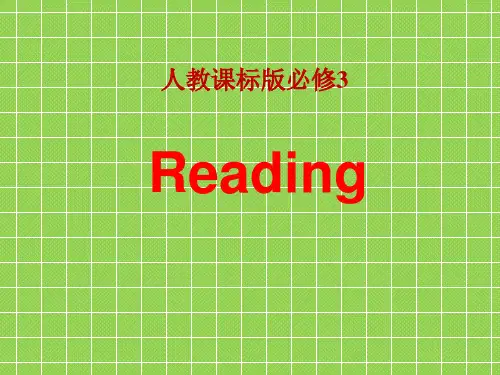

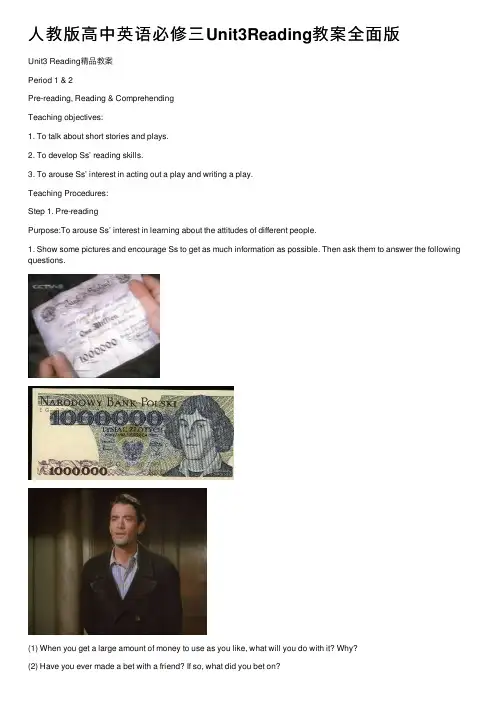
⼈教版⾼中英语必修三Unit3Reading教案全⾯版Unit3 Reading精品教案Period 1 & 2Pre-reading, Reading & ComprehendingTeaching objectives:1. To talk about short stories and plays.2. To develop Ss’ reading skills.3. To arouse Ss’ interest in acting out a play and writing a play.Teaching Procedures:Step 1. Pre-readingPurpose:To arouse Ss’ interest in learning about the attitudes of different people.1. Show some pictures and encourage Ss to get as much information as possible. Then ask them to answer the following questions.(1) When you get a large amount of money to use as you like, what will you do with it? Why?(2) Have you ever made a bet with a friend? If so, what did you bet on?(3) How did you feel about the bet after it was won or lost?(4) Have you ever rea d the story “The Million Pound Bank-Note”?(5) Have you seen the movie? If so, what did you think of it?2. Get Ss to talk freely with their partners about the value and use of money. After talking, ask Ss to present their opinions in class.For Your Reference:S1: I’ll buy a big house, a new car of my own and get married to a beautiful girl. In my opinion, the most important thing for a person is to enjoy the life. So, if I have a lot of money, I’ll make full use of it to meet my needs for a rich life. S2: I’ll give some money of the one million pound to the poor people in the western part of our country to help them live a happy life, especially the children.Because they really need help and they can learn more knowledge in order to develop the western part of our country. This way of spending money ismeaningful.S3: ...Step 2. Leading-inPurpose:To stimulate Ss’ interest in reading the text.Ask Ss to think about the following questions and talk about the answers.1. How did Henry get the Million Pound Bank-Note?2. Do you agree that the money can bring Henry happiness?3. What will Henry do with the note?4. How many characters are there in this scene?5. When and where did the story happen?Step 3. Fast readingPurpose: To get the gist of the passage.1. Ask Ss to read the text quickly and try to get the main idea of the text.2. Ask Ss to finish the following exercises according to the text.(1) Which is the right order of the events according to the text?① Henry wandered in London streets.② About a month ago, Henry Adams was sailing out of the bay.③ The next morning he was spotted by a ship.④ Towards nightfall he found himself carried out to sea by a strong wind.⑤ On the ship he earned his passage by working as an unpaid hand.A. ①②③④⑤B. ②③④⑤①C. ②④③①⑤D. ②④③⑤①(2) What’s the servant’s name?A. RoderickB. HenryC. OliverD. James(3) Which of the following statements about Henry is NOT true?A. Henry comes from the USA.B. He worked for a mining company in America.C. He arrives in England as planned.D. He wants to find work in London.(4) Which of the following statements is NOT one of the reasons why the brothers decide to choose Henry?A. He is an American.B. He doesn’t have any money.C. He is a hard-working man.D. He is honest.(5) Why did the narrator say “you’re about to hear the most incredible tale”?A. Because Henry Adams survived at sea.B. Because Henry Adams earned his passage by working as an unpaid hand.C. Because Roderick and Oliver invited Henry to step in and asked him questions.D. Because Henry Adams, a tramp, was given some money for reasons unknown to him.(6) Why did the two brothers give Henry Adams an envelope?A. They wanted to play a trick on Henry.B. They had a pity on Henry.C. They made a bet.D. Henry was not an English man.(7) How did Henry Adams feel when he got an envelope from the brothers?A. sadB. happyC. astonishedD. He took it for granted.Suggested Answers:(1) D (2) D (3) C (4) C (5) D (6) C (7) CStep 4. Intensive readingPurpose: to get the students to learn the details of the text.1. Ask Ss to read the text again and finish Ex1 of Comprehending on P19.2. Ask Ss to talk in pairs and answer the following questions.(1) How did Henry Adams come to England?(2) Where did Henry work before? How much did he have?(3) What did the two gentlemen give Henry?(4) When can Henry open the letter?Suggested Answers:(1)It was the ship that brought him to England.(2)He worked for a mining company before and he had no money at all.(3)They gave him a letter.(4) He can’t open it until two o’clock.3. Ask Ss to read the text very carefully and finish the following table.Suggested Answers:(1) summer (2) 1903 (3) London (4) American businessman (5) lost (6) find a job (7) brothers (8) invited (9) questions (10) a million pound bank-note (11) bet4. Ask Ss to answer the following question and try to find out the relative sentences. What kind of person are the characters? Suggested Answers:◆ Henry Adams: He earns his passage by working on a ship to England. (proud)He arrived in England by accident after not sailing his boat well. (careless)He asks for a job not charity. (honest)◆ Roderick and Oliver: having servants and not worrying about giving a stranger amillion pound bank-note. (rich)prepared to bet one million pounds just for a bit of fun. (mischievous)They see that Henry is honest and proud. (good judges of character)5. Ask Ss to have a small discussion to draw a summary of the whole text. Suggested Answer:Henry, a San Francisco businessman is rescued at sea by a British ship that takes him to London where he finds himselfwithout money, friends or the hope of finding a good job. Hungry and alone, he walks on the streets of the city when unexpectedly he is asked to a large and grand house. Two rich brothers, Roderick and Oliver, have made a secret bet. Roderick believes that a man cannot survive in the city for a month with only a million pound bank-note in his possession but Oliver believes he can. The play takes us along on Henry’s misadventures with humor and surprise to discover who will win the bet.Step 5. Language point1. go ahead(1) 进⾏;发⽣The building of the new bridge will go ahead as planned. 新桥的建设将会按照计划进⾏。
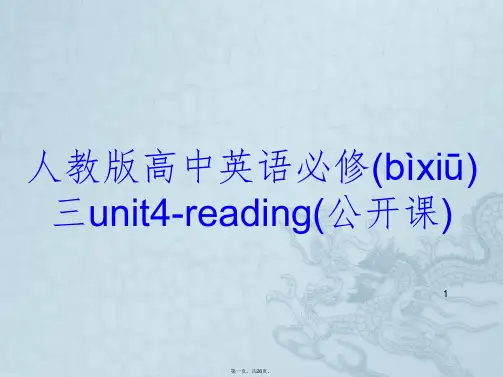

2019新人教高中英语必修三Unit4 Space explorationReading and Thinking公开课教案Teaching aims:1.Enable students tolearnaboutthedevelopmentandsignificanthistoricaleventsofspaceexploration.2.Enable students tolearnaboutChina’sachievementsinspaceandcontributionstospaceexploration.3.Help students toanalysethestructureofthearticleandsummarisethemainideaforeachparagraph.4.Guide students toexpressyouropinionsonspaceexploration.Teaching key points:1.Lead students to learn about the development of space exploration.2.Help students learn about China’s achievements on space exploration.3.Help students analyse the structure of the article and summarise the main idea.Teaching difficult points:1.Enable students to figure out the structure and summarise the main idea.2.Lead students to express their opinions on space exploration.Teaching procedures:Step Ⅰ Lead-inPlay a clip from Star Trek and show students a monologue from Captain James Kirk.“Space, the final fro ntier. These are the voyages of starship Enterprise, its continuing mission, to explore strange new worlds, to seek out new life and civilizations, to boldly go where no man has gone before.”StepⅡPre-readingBeforeyouread,lookatthetitleandthephotosonpages40-41.Discussthesequestions inpairs.1.Whatdoyouthinkarethemainreasonsforspaceexploration?2.Whatdoyouexpecttoreadaboutinthistext?Suggested answers:1.Themainreasonsforspaceexplorationaretofurtherhumanexplorationandtogath erknowledgeoftheuniverse.2.Iexpecttoreadaboutthehistoryofspacetravel,thereasonswhyweexplorespace,w hatspaceexplorationhasgivenus,howwecontinuetoexplorefurther,etc.StepⅢ While-readingActivity1Readthetext.Severalsentenceshavebeenremovedfromthetext.Choosethecorrectsent ence(A-D)tofilleachgap.A.Althoughscientiststrytomakesurenothinggoeswrong,accidentscanstillhappen.B.Theyalsoreallywishtodiscoverotherplanetsthataresuitableenoughtosupportlife.C.Thefutureofspaceexplorationremainsbright.D.Afterman yexperiments,theysucceededinmakingrocketsthatcouldescapeEarth’s gravity.Questions:1.Whichsentencesaregeneralstatementsthatcouldserveastopicsenten cesforparagraphs?2.Whichsentencecontainsalinkingwordwhichindicatesthatitisapartofalistofdetails3.Whichsentencebeginswithasequencewordshowingthatitisprobablyadetailfrom themiddleofanarrative?Suggested answers:B,D,A,C1.AandC2.B also3.D AfterActivity2Useyourownwordstosummarisethemainideaforeachparagraph.SummarisethemainideaWhenthemainideaisnotclearlystatedinatopicsentence,youshouldreadthefullpara graphorpassagecarefullyandfindthewordsorideasthatrepeatthemselves.Theyarelikely evidenceoftheauthor’smainidea.Paragraph1:Peopleare andscientists . Paragraph2:Inthe20thcentury, .Paragraph3:Humans inspiteof . Paragraph4:China’sspaceprogramme . Paragraph5:Thefutureofspaceexploration . Suggested answers:Paragraph1:curiousaboutspace;workhardtofindanswersParagraph2:AmericanandSovietspacemissionsmadespacetravelareality Paragraph3:continuethespaceexploration;thegreatrisksParagraph4:hasmadegreatprogress,becomingthe3rdcountrytoindependentlysen dhumansintospaceParagraph5:looksbright,asmanycountriesareplanningfurthermissions Activity3AnalysethestructureSuggested answers:why;how;whatActivity 4 Read for the historical events of space exploration. Launc hingTimeMissionsAstronauts/ AgencyAchievements4Octo ber1957 Sputnik1TheUSSR12Apr il1961Thefirstpersonintheworldtogointospace 20July 1969 NeilAr mstrong5SeptNASAspStudiesdeepspace,stilltransmitsdatatember1977 aceagencyodayTheUSSR’sSoyuz11andAmerica’sChallenger2003 Shenzhou5Shenzhou6 CompletedasecondmannedorbitShenzhou7JadeRabbit SenttothemoontostudyitssurfaceTiangong2 AspacelabTodockwithTiangong2;signaledonestepfurthertoestablishaspacestationinthefutureChang’e4Suggested answers:Launc hingTime MissionsAstronauts/AgencyAchievements4Octo ber1957 Sputnik1TheUSSRSuccessfullyorbitedaroundEarth12Apr il1961YuriGagarin(theUSSR)Thefirstpersonintheworldtogointospace20July 1969NeilArmstrongSteppedontothemoon5September1977 Voyager1NASAspaceagencyStudiesdeepspace,stilltransmitsdatatodayTheUSSR’sSoyuz11andAmerica’sChallengerFailed2003 Shenzhou5YangLiweiChinabecamethethirdcountryintheworldtoindependentlysendhumansintospaceShenzhou6 Completedasecondmannedorbit Shenzhou7 ThefirstChinesespacewalk JadeRabbit Senttothemoontostudyitssurface Tiangong2 AspacelabLaunc hingTimeMissionsAstronauts/AgencyAchievements Tianzhou1TodockwithTiangong2;signaledonestepfurthertoestablishaspacestationinthefutureChang’e4ExplorethesurfaceofthefarsideofthemoontomakemeasurementsandobservationsActivity 5 Analysethewritingtechniques1.Whatgenreisthepassage?Whatareitsfeatures?2.Howdoesthetextdevelop?3.Whatwritingtechniquesareusedinthisarticle?4.Wherecanyoufindthiskindofpassage?Suggested answers:1.Itisapopularsciencearticle(科普说明文).Features:Abriefandeye-catchingtitle;Explaininggeneralconceptsinasimplifiedway;Emphasisingonmainevents;Usingquotes,metaphors(比喻),analogies(类比)toexplaindifficultorabstractscientificconcepts;Listingdataornumbers.2.Itdevelopsinchronologicalorder.3.Givingexamples,usingquotesandlistingimportantevents.4.Itispresentedinmanyforms,includingbooks,filmsandtelevisiondocumentaries,m agazinearticles,webpages,etc.StepⅣ Post-readingDiscussthequestions.Workinpairs.1.Whatisthewriter’sattitudetowardsspaceexploration?Findevidencefromthetextt osupportyouridea.2.Whatdoesthetitle “Space:TheFinalFrontier” meantoyou?Shareyourideaswiththewholeclass.Suggested answers:1.Thewriterfeelspositiveaboutfuturespaceexplorationandemphasisesthisattitude bypresentingimportanteventsinthehistoryofspaceexploration,givingexamples,usingqu otes,andshowingrespectandgratitudeforthecontributionsscientistsandastronautshave made.2.frontier:aborderbetweentwocountries;awildernessattheedgeofasettledareaor acountry;anundevelopedfieldofstudyfinal:implyingtherewereotherhumanfrontiersbeforespace,suchasphysicalfrontier s(thediscoveryofAmerica,theArcticandthedeepsea);andscientificfrontiers(advancesin medicineandtechnology)...Space:thefinalfrontier:Spaceisthelastfieldthatremainsmysteriousandunknownto mankind.WhileIsupportspaceexploration,Idon’tthinkspaceisthefinalfrontierjustyet.Thereis stillmuchtolearnabouttheearth,andweareonlyattheverybeginningofnewtechnological breakthroughsinvolvinginformationtechnologyandAI.Therearemanyscientificandtech nologicalfrontiersallaroundus.StepⅤ SummaryHumanshavebeendreamingoftravellingtospacetofindoutmoreabouttheuniverse. Theymakevariouskindsof1.(vehicle)tocarrycourageouspeopleintospacetofindoutthesecretsoftheuniverse.On4October1957,theSputnik1satellite2.(launch)bytheUSSRandsuccessfullyorbitedaroundtheEarth.Afterthat,theUSSRfocused on3.(send)peopleintospace,andon12April1961,YuriGagarinbecamethefirstpersoninthewor ld4.(go)intospace.Overeightyearslater,AmericanastronautNeilArmstrongsteppedontothe moon.Inspiringasthespaceexplorationseems,itmaybedangerousand5.________(challen ge)toexploretheuniverse.Someastronautsevenlosttheirlivesduringthemissions.6. allthedifficultiesandrisks,scientistshavebeencontinuingthei rwork.China’sspaceprogra mmestartedlaterthanthoseofRussiaandtheUS,butithasmadesplendidprogressin7. shorttime.Chinabecamethethirdcountryintheworldto8.(independent)sendhumansintospacein2003,9. YangLiweisuccessfullyorbitedEarthintheShenzhou5spacecraft.Sincethen,Chinahasma deaseriesofachievements.It’shopedthat10.(far)discoverieswillmakeusunderstandhowtheuniversebeganandalsohelpussurvivewel lintothefuture.Suggested answers:1.vehicles2.waslaunched3.sending4.togo5.challenging6.Despite7.a8.independently9.when10.further。
2019新人教高中英语选择性必修三Unit 3 Environmental ProtectionReading and Thinking公开课教案Teaching aims:1.Enable students to know about climate change and summarise the main idea of each paragraph.2.Guide students to learn about the“greenhouse effect” and create a diagram describing how it works.3.Help students to analyse the consequences of climate change and enhance the awareness of environmental protection.4.Voice your personal opinions about how to deal with climate change.Teaching key points:1.Figure out the main idea of the text and the topic of each paragraph.2.Analyse the consequences of climate change and enhance the awareness of environmental protection.Teaching difficult points:1.Learn about the “greenhouse effect” and create a diagram describing how it works.2.Voice their personal opinions about how to deal with climate change.Teaching procedures:StepⅠDiscuss the Opening PageView the Opening Page of this unit and answer the questions below.1.Where do you think this photo was taken?2.What does this photo make you think of?Suggested answers:1.I think this photo was taken in either the Arctic or Antarctica,as those places have large ice sheets like this.2.This photo makes me think of the earth is becoming warmer—global warming,which causes great damage.StepⅠPre-readingPredict what aspects about climate change will be talked about in the text.Before your reading,list details in the first two columns.Fill in the last column after reading.Climate change—global warmingWhat I Know (K)What I Want to Know(W)What I Have Learnt (L)Look at the title “Climate Change Requires the World’s Attention”,the graphs and the pictures Page 26,answer the following questions.1.Where would you most likely find this text?2.What is the graph about?What information can you get from it?3.Guess what might happen to the polar bear in the photo?How did it die?4.What do you think will be talked about in the text?Suggested answers:Climate change—global warmingWhat I Know (K)What I Want toKnow(W)What I Have Learnt (L)global warming;carbon dioxide;sea level rises;Polar animals are losing home;water resource shortage;coastal cities could be flooded...I want to knowhow the greenhouseeffect works,andmore measures weshould take toprevent globalwarming.“natural” greenhouseeffect;“man-made”greenhouseeffect;makepolicies;reduce“carbonfootprint”1.In a science magazine.2.The graph is about the global surface temperature during 1920-2016 base period.The temperature of the global surface rose about 1.2℃ from 1920 to 2016.The Earth is becoming warmer and warmer.3.The polar bear lying on the ground is dead.It is “skin and bones”.Maybe it hasstarved to death because of food shortage caused by climate change.4.The text will talk about the reasons and impacts of global climate change,and what we humans should do.StepⅠWhile-readingActivity 1Reading for the main idea and the structureSkim the text and match the main idea of each paragraph.Paragraph 1 A.The reasons causing the increase in temperature.Paragraph 2 B.Introduce the present situation about climate change.Paragraph 3C.A real case showed the great impact the increase in temperature had on Earth’s ecology.Paragraph 4D.What should we human do about global warming.Paragraph 5E.The serious consequences of global warming.Suggested answers:Paragraph 1:BParagraph 2:CParagraph 3:AParagraph 4:EParagraph 5:DActivity 2Reading for detailsSuppose you were Li Ming.You are invited to attend the World Economic and Environmental Conferences.And you will be interviewed by a journalist.Please answer his questions with what you learn from this text.Read Paragraph 1 & Paragraph 2 carefully and answer the questions.1.What happened to the Earth?Can you list some evidence of it?2.What happened to the polar bear in the photo?How did it die?Why did the writer write about it?Suggested answers:1.The global climate has changed.The Earth is getting warmer and warmer.A warming ocean and atmosphere along with melting ice and rising sea levelsprovide evidence of a dramatic change in the global climate.2.The polar bear in the photo died of starvation.Low sea-ice levels caused by climate change made the bear couldn’t hunt seals as before.It had to travel greater distances in order to find food.The writer wrote about it because it showed one of the effects of rising temperatures due to climate change.The seriousness of global warming is better illustrated by a real case.Activity 3Read Paragraph 3 carefully and create a diagram describing how the greenhouse effect works.1.What caused the increase in the global average surface temperature?2.Create a diagram describing how the greenhouse effect works.3.What are the consequences of high greenhouse gas emissions?Suggested answers:1.It is the “greenhouse effect”,including the “natural” and the “man-made” greenhouse effect.2.The diagram describing how the greenhouse effect works.3.High greenhouse gas emissions lead to more heat energy being trapped in the atmosphere and rising temperature.Activity 4Read Paragraph 4 carefully and finish the mind map.What are the results of the rise in temperature?Suggested answers:Activity 5What we should do about global warmingGovernments:1._________________________2._________________________Individuals:1._________________________2.___________________________Suggested answers:Governments:Make policies;Take appropriate actions and measures to reduce greenhouse gas emissions.Individuals:Reduce our “carbon footprint” by restricting the amount of carbon dioxide our lifestyles produce.Seize every opportunity to educate everyone about global warming.StepⅠ Post-reading—Critical and Creative ThinkingDiscuss these questions in groups.1.Who do you think should take responsibility for dealing with climate change?(individuals,large business companies or governments)2.“We individuals can also reduce our ‘carbon footprint’ by restricting the amount of carbon dioxide our lifestyles produce”.What can we do to live a low-carbon lifestyle?Suggested answers:1.For example:Every individual can make a big difference.I firmly believe that each individual citizen cannot sit back and say it is someone else ’s responsibility to protect environment.We must play our roles in the society.2.The answers vary.StepⅠ Homework1.Finish what you have learned in the last column of KWL chart.2.Earth Day is on April 22nd every year.In order to raise public awareness of existing environmental problems and mobilize people to participate in the environmental movement,the city will hold a speech contest this weekend with the theme of “Green life,save our home”.As a representative of your school,you will take part in the contest.Please prepare your speech.Suggested answers:1.I have learnt many useful words and expressions to discuss climate change.Learn about what the “natural” greenhouse effect and the “man-made” greenhouse effect are.What can we do to deal with global warming.dies and gentlemen,I am honoured to stand here to share with you on such an important subject as climate change.Yes,it is global warming.Let me give you two phenomena.Here is the first one.More and more people are used to using air conditioning but how many people have ever thought whether this new hobby will bring side-effects or not?Maybe just few people.In fact,the side-effect is apparent.The gases exhausted from air conditioning contain a lot of methane which could cause global warming.By the way,air conditioning will waste a lot of electricity.The second one is about the increasing number of cars.According to the statistics,in the 21st century,there are 7 millions cars in the world,a large number of exhaust gases has seriously influenced us,such as:cough,throat inflammation.These two phenomena are just a few parts of reasons which change our environment badly.There are many other reasons.In the nearly 100 years,the global average temperature experienced fluctuations twice.Generally,it is the trend that the global climate is becoming warmer and warmer.In 1980s,the global temperature rose apparently.According to Chinese scientists,the average temperature in China has risen by 1 degree centigrade in the last 5 decades.It is higher than the reported global average.We are seeing more frequent bouts of extreme weather.In many parts of the country,environmental damage and climate change are realities for us.In my opinion,it is high time for us to take action.In order to save the earth,we should try to do things below:no air conditioning,use recycled paper,abandon meat food,don’t use plastic bags,take a bus.It is little drops of life.As long as everyone takes action,it will be a powerful strength to rescue our planet.All countries are supposed to take the legislative initiative as soon as possible.Only in this way can the global warming be put under control.。